Overactive bladder (OAB) is a diagnosis based on patient symptoms. Bothersome urinary symptoms of OAB are marked by urgency (a sudden sensation to urinate that is difficult to delay, also known as a “gotta go” sensation).
Other symptoms may include increased daytime or nighttime frequency (normal voiding includes about 6 voids per day) and urge incontinence (urine leakage on the way to the toilet). Inappropriate bladder contractions lead to an uncontrollable urge to urinate. OAB is present in about 10-30% in men and 10-40% in women. Only about one-third of cases resolve in a given year but most patients experience symptoms for many years.
Causes and Risk Factors
Many different factors may underlie OAB symptoms and can include:
- Increased age
- Obesity
- Lifestyle (caffeine and alcohol use, excessive fluid consumption, spicy/acidic foods)
- Medications (diuretics, also known as “water pills”)
- Neurological conditions (stroke, spinal cord injury, Parkinson’s disease, multiple sclerosis, diabetes, spinal surgery or herniated discs)
- Bladder conditions (urinary tract infections, bladder tumors, bladder stones, prostate enlargement)
- Pelvic organ prolapse (cystocele, also known as a “dropped bladder).
When to Speak with a Urologist about Overactive Bladder
You should speak to a Urologist about Overactive Bladder if you are bothered by sudden sensations that you need to rush to the bathroom to urinate, by a need to urinate frequently, or if you leak urine on the way to the toilet.
What to Expect when Seeking Treatment
In addition to a history and physical examination, initial assessment includes a urinalysis to rule out other potential causes of these urinary symptoms, such as urinary tract infection. Patients also typically complete a voiding diary, or journal, which captures when and how much they urinate for three separate 24-hour periods. The voiding diary helps assess the extent of OAB symptoms and any subsequent response to therapy. Other testing may include a postvoid residual assessment to check for incomplete bladder emptying, cystoscopy with a small telescope passed into the bladder to rule out anatomic causes, and urodynamic studies to measure the bladder’s ability to store and release urine.
Treatment Options
It is important to recognize that most treatments can improve OAB symptoms though rarely eliminate them completely. Treatment modifications are frequently required to achieve a sufficient level of symptom control and escalations in treatment may be necessary. Persistence with a given therapy is critical to achieve benefit.
First-line therapies entail behavioral modification. Various behavioral modification techniques to limit symptoms include: moderate reduction in fluid intake, avoiding bladder irritants such as caffeine and alcohol, altering diuretic medications, and controlling chronic medical conditions such as obesity and diabetes. Further techniques include working with a pelvic floor physical therapist to learn “quick flick” contractions of the pelvic floor muscles upon urge sensation to retrain the bladder as well as development of voiding schedules with gradually increasing intervals.
Second-line therapies involve oral medications, such as anti-muscarinics or beta-3 agonists. These medications reduce urgency and urge incontinence episodes by about half. Anti-muscarinic medications can cause dry mouth (30%), constipation (10%), blurred vision, urinary retention and altered cognition in the elderly. Anti-muscarinic agents cannot be used in the setting of narrow-angle glaucoma or delayed gastric emptying. Beta-3 agonists have relatively minimal potential side effects though may increase blood pressure very slightly. An initial medication should be tried for at least 8 weeks before determining if symptom control is sufficient and potentially shifting to alternative oral medication for another 8-week trial.
Third-line treatments include bladder Botox injection or neuromodulation with either Urgent PC tibial nerve stimulation or implantation of Interstim sacral nerve modulator. Injection of Botox 100 units results in >50% improvement for about 70% of patients and 50% of patients with incontinence become dry. But, Botox requires repeat injection about every 9 months and there is a 5% risk of temporarily needing to perform self-catheterization. Peripheral tibial nerve stimulation is typically administered for 30 minutes weekly for 12 weeks and has similar efficacy to oral medications with minimal side effects though may not be possible in patients with significant lower extremity swelling. Interstim implantation results in >50% improvement in almost 90% of patients and. In general, patients experience about 50% greater improvement than with oral medications alone. The Interstim device battery must be replaced about every 5 years and makes it not possible to have MRI scans below the neck. Rare complications can be associated with this procedure, including pain, infection, and need for surgical revision.

